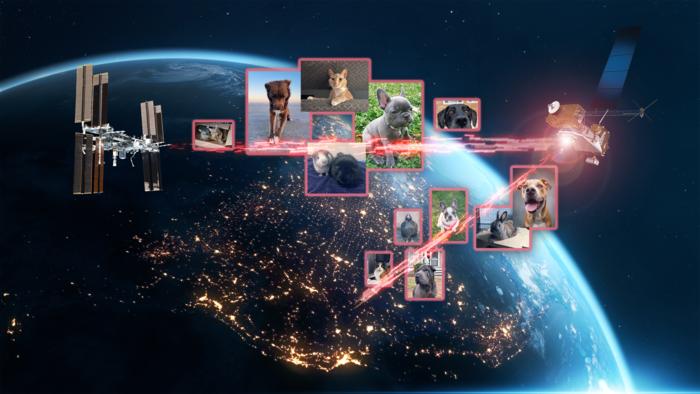NASA has taken a giant leap forward in space communications by successfully transmitting cherished pet photos and videos through its first two-way, end-to-end laser relay system at an astonishing rate of 1.2 gigabits per second – surpassing most home internet speeds. The demonstration, featuring submissions from NASA astronauts Randy Bresnik, Christina Koch, Kjell Lindgren, and other agency employees, showcased the power of laser communications while testing a new networking technique.
The pet imagery campaign, inspired by the “Taters the Cat” video transmitted 19 million miles over laser links to the Deep Space Optical Communications (DSOC) payload on the Psyche mission, has been a rewarding experience for the teams involved. “Not only have they demonstrated how these technologies can play an essential role in enabling NASA’s future science and exploration missions, it also provided a fun opportunity for the teams to “picture” their pets assisting with this innovative demonstration,” said Kevin Coggins, deputy associate administrator and SCaN program manager at NASA Headquarters in Washington.
A Journey Through Space: From Earth to the ISS via Laser Links
The images and videos embarked on a complex journey, starting from a computer at a mission operations center in Las Cruces, New Mexico. NASA routed the data to optical ground stations in California and Hawaii, where teams modulated the information onto infrared light signals, or lasers, and sent them to NASA’s Laser Communications Relay Demonstration (LCRD) located 22,000 miles above Earth in geosynchronous orbit. LCRD then relayed the data to the Integrated LCRD Low Earth Orbit User Modem and Amplifier Terminal (ILLUMA-T), a payload currently mounted on the outside of the International Space Station.
Laser communications, also known as optical communications, employ infrared light instead of radio waves to send and receive information. While both infrared and radio travel at the speed of light, infrared light can transfer more data in a single link due to its tighter wavelength, making it more efficient for science data transfer.
Overcoming Space Communication Challenges with High-Rate Delay Tolerant Networking
To address the challenges of data transmission across vast distances in space, NASA developed a suite of communications networking protocols called Delay / Disruption Tolerant Networking (DTN). The “store-and-forward” process used by DTN allows data to be forwarded as it is received or stored for future transmission if signals become disrupted.
NASA’s Glenn Research Center in Cleveland developed an advanced implementation called High-Rate Delay Tolerant Networking (HDTN) to enable DTN at higher data rates. This networking technology acts as a high-speed path for moving data between spacecraft and across communication systems, enabling data transfer at up to four times faster than current DTN technology.
The HDTN implementation aggregates data from various sources, like discoveries from the scientific instrumentation on the space station, and prepares the data for transmission back to Earth. For the pet photo and video experiment, the content was routed using DTN protocols as they traveled from Earth to LCRD, to ILLUMA-T on the space station, where an onboard HDTN payload demonstrated its ability to receive and reassemble the data into files.
As NASA’s Artemis campaign prepares to establish a sustainable presence on and around the Moon, SCaN will continue to develop ground-breaking communications technology to bring the scalability, reliability, and performance of the Earth-based internet to space.


